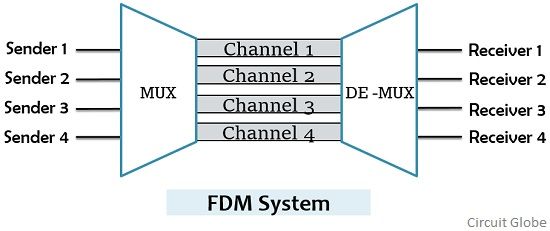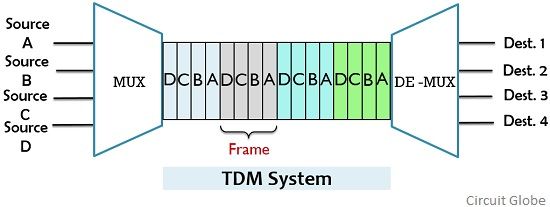FDM and TDM are the two types of multiplexing technique that allows simultaneous transmission of multiple signals over only one channel. One of the major difference between FDM and TDM is that in FDM, multiple signals are transmitted by occupying different frequency slots. As against in TDM, the various signal gets transmitted in multiple time slots.
We all know that multiplexing is a technique of transmission of multiple signals over a common channel. But transmitting multiple signals over a common channel is quite difficult. However, multiplexing makes this possible.
Here, in this article, we will discuss what are the factors, that generates differences between two types of multiplexing techniques.
Content: FDM Vs TDM
Comparison Chart
| Basis for Comparison | FDM | TDM |
|---|---|---|
| Definition | A technique that allows transmission of multiple signals using different frequency slots over a common link. | A technique that permits the flow of multiple data signal over a communication link in different time domains. |
| Stands for | Frequency Division Multiplexing | Time Division Multiplexing |
| Multiplexing technique | Analog | Digital |
| Synchronization | Not Needed | Necessary |
| Circuit Orientation | Complex | Comparatively simple. |
| Cross talk | Exist | Does not exist |
| Propagation Delay | Not sensitive | Sensitive |
| Efficiency | Less | More efficient than FDM system |
| Cost | High | Comparatively low. |
Definition of FDM
FDM is an abbreviation used for frequency division multiplexing. In FDM, multiple transmitted signals use a common channel but the total available bandwidth is utilized among the various signals. This implies that over a complete channel a particular frequency slot is allotted to only one signal.
Basically, in FDM, a different frequency band is used to modulate different data signal. This means that different carrier frequency modulates the various signals that are to be transmitted over the channel. Further, the modulated signals are mixed and transmitted over a single communication link. The figure below shows the process of frequency division multiplexing:
 From the figure shown above, it is clear that a single channel is divided into multiple parts. And each part is nothing but a separate channel carrying a signal or data stream. The technique of FDM is also known as analog multiplexing as it is used for multiplexing of analog signals.
From the figure shown above, it is clear that a single channel is divided into multiple parts. And each part is nothing but a separate channel carrying a signal or data stream. The technique of FDM is also known as analog multiplexing as it is used for multiplexing of analog signals.
But the question arises if the signals are transmitted by this technique then there exist chances of interference between the different frequency signals.
So, to reduce the chances of interference between the simultaneously transmitted signals, guard bands are provided between the frequency slots. Guard bands are nothing but unused frequency slot in the entire band that avoids overlapping of one frequency channel with the other.
Once the signal gets transmitted over the channel, then at the receiver end, demultiplexing of the signal is performed in order to separate various signals from one another.
Definition of TDM
TDM stands time division multiplexing. It is a multiplexing technique that allows transmission of multiple signals over a common channel but in different time slots. Each signal will get transmitted very quickly over the channel but at a time only one signal will be transmitted. So basically in TDM, the overall transmission time is divided according to the multiple signals required to be transmitted over the common link.
Each transmitted source is allotted with one or more time slot in each frame for the transmission of the signal. The figure below shows the transmission of 4 different source signals using time division multiplexing:
Here as we can see that signals from 4 different sources are multiplexed together. So, the 4 separate TDM frames are generated that gets transmitted over the channel in different time slots.
TDM can be classified into two categories:
Synchronous TDM
In synchronous TDM, the system does not care whether each source is having signal or data for transmission or not. It pre-assigns the slots to each individual source in the beginning. So, at the time of transmission, in the absence of data unit from an individual source, that particular time slot will not get totally utilized.
This turns out to be a drawback in case of synchronous TDM system because the allotted time duration is not utilized efficiently.
Asynchronous TDM
Unlike synchronous TDM, in case of asynchronous TDM, the time slot is assigned to only that particular source that holds a data or signal to transmit. Therefore, in this case, it is not necessary to have an equal number of frames as that of the number of sources to be transmitted.
Key Differences Between FDM and TDM
- The technique of frequency division multiplexing is used majorly in case of analog signal transmission. While the time division multiplexing is a digital signal transmission scheme.
- In TDM multiple signals are transmitted in different time domains, thus the chances of crosstalk between the signals are negligible. However, in FDM the signals are allotted different frequency slots, this leads to the possibility of crosstalk while signal transmission.
- TDM technique requires synchronized signal transmission, as time slot to each signal is pre-assigned, thus beginning of each pulse requires a synchronization pulse. While in FDM no such synchronization pulse is required.
- The circuit orientation of FDM is quite complex, whereas that of TDM is simple.
- FDM is a comparatively an expensive multiplexing technique than the TDM.
- FDM offers low efficiency because the technique is more prone to cause interference while transmission. Whereas, TDM is highly efficient because the chances of interference are less in its case.
- As the signals are getting transmitted in different time slots in TDM thus it leads to propagation delays. However, FDM does not cause a delay in propagation.
Conclusion
From the above discussion, we can say that in FDM guard bands are required to separated different frequency slots, otherwise inter-channel crosstalk cannot be prevented. But no such thing is required in TDM because at the initial level, time slots are assigned to the signal.

